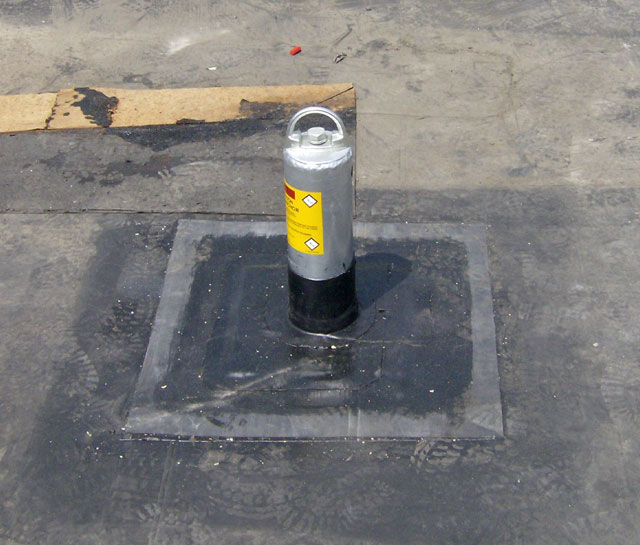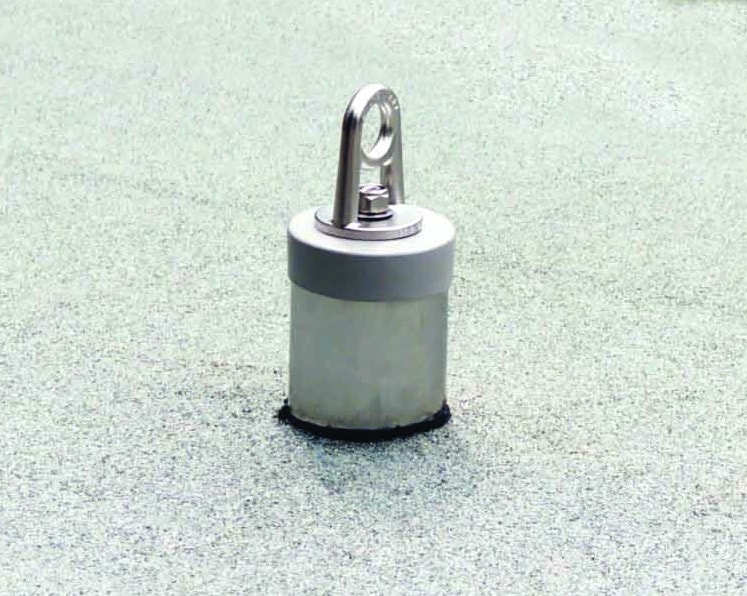Rigid Post Single Point Anchors
Rigid Post Single Point Anchors are ideal for rooftop applications with 5:12 or greater pitches, in instances where roof decking materials such as metal or concrete lack the structural integrity to absorb the load associated with a fall, and suspended activities such as window washing and stadium camera applications. Rigid Post Single Point Anchors are cost effective solutions that feature ease of use, making them an ideal fall protection solution for clearly designated work areas in which a wide range of motion is not required.

Rigid Post Single Point Anchor clamped to a beam

Rigid Post Single Point Anchor integrated as part of a membrane roof

Rigid Post Single Point Anchors

Rigid Post Single Point Anchors

We are a complete turnkey provider of OSHA compliant fall protection systems and have years of experience designing and installing single point anchors. Contact us for expert assistance with your fall arrest, fall restraint and fall protection safety requirements.
Applications
-
Roof Fall Protection
View Roof Fall Protection -
Window Washing
View Window Washing -
Stadiums, Arenas, Convention Centers
View Stadiums, Arenas, Convention Centers
Design Considerations
Because Rigid Post Single Point Anchors used in rooftop applications are commonly attached structural steel members beneath the roof deck, their installation is a more complex undertaking than other rooftop anchors. Non-engineered single point anchors must be rated rated at 5,000 for one user or 10,000 lbs. for two users. Engineered systems must be designed for 2 times the applied load in the event of a fall by a qualified person. A single point anchor may be designed for single or dual tie-off as long as each user attaches to a designated D-Ring. Multiple users should never tie off to the same D-Ring under any circumstances. Special care must be taken to train personnel in the proper use of single point anchors. An SPA is designed to protect workers within a 30 degree conical cone; moving outside the intended coverage area increases the likelihood of coming into contact with structure below the work area in the event of a swing fall.
OSHA Regulations
- Rigid Post Single Point Anchor OSHA Regulations
- 1926.502(d)(15) Anchorages used for attachment of personal fall arrest equipment shall be independent of any anchorage being used to support or suspend platforms and capable of supporting at least 5,000 pounds (22.2 kN) per employee attached, or shall be designed, installed, and used as follows:
- 1926.502(d)(15)(i) as part of a complete personal fall arrest system which maintains a safety factor of at least two; and
- 1926.502(d)(15)(ii) under the supervision of a qualified person.
Personal Fall Protection System This section is applicable if the personal fall protection system is being used by an employee having a combined body and tool weight of LESS THAN 310 pounds (140 kg). NOTE: Additional requirements for personal fall arrest systems and positioning systems for an employee having a combined body and tool weight of MORE THAN 310 pounds are contained in paragraphs (d) and (e) of OSHA 1910.140. The employer must ensure that personal fall protection systems meet the following requirements:
- Connectors must be drop forged, pressed or formed steel, or made of equivalent materials. 1910.140(c)(2)
- Connectors must have a corrosion-resistant finish, and all surfaces and edges must be smooth to prevent damage to interfacing parts of the system. 1910.140(c)(3)
- When vertical lifelines are used, each employee must be attached to a separate lifeline. 1910.140(c)(4)
- Lanyards and vertical lifelines must have a minimum breaking strength of 5,000 pounds (22.2 kN). 1910.140(c)(5)
- Self-retracting lifelines and lanyards that automatically limit free fall distance to 2 feet (0.61 m) or less must have components capable of sustaining a minimum tensile load of 3,000 pounds (13.3 kN) applied to the device with the lifeline or lanyard in the fully extended position. 1910.140(c)(6)
- A competent person or qualified person must inspect each knot in a lanyard or vertical lifeline to ensure that it meets the requirements of paragraphs (c)(4) and (5) of this section before any employee uses the lanyard or lifeline. 1910.140(c)(7)
- D-rings, snaphooks, and carabiners must be capable of sustaining a minimum tensile load of 5,000 pounds (22.2 kN). 1910.140(c)(8)
- D-rings, snaphooks, and carabiners must be proof tested to a minimum tensile load of 3,600 pounds (16 kN) without cracking, breaking, or incurring permanent deformation. The gate strength of snaphooks and carabiners, must be proof tested to 3,600 lbs. (16 kN) in all directions. 1910.140(c)(9)
- Snaphooks and carabiners must be the automatic locking type that require at least two separate, consecutive movements to open. 1910.140(c)(10)
Snaphooks and carabiners must not be connected to any of the following unless they are designed for such connections: 1910.140(c)(10)(i)
- Directly to webbing, rope, or wire rope; 1910.140(c)(10)(ii)
- To each other; 1910.140(c)(10)(iii)
- To a D-ring to which another snaphook, carabiner, or connector is attached; 1910.140(c)(10)(iv)
- To a horizontal life line; or 1910.140(c)(10)(v)
- To any object that is incompatibly shaped or dimensioned in relation to the snaphook or carabiner such that unintentional disengagement could occur when the connected object depresses the snaphook or carabiner gate, allowing the components to separate. 1910.140(c)(11)
Talk to a fall protection specialist
Tell us about your fall protection needs, and we’ll configure a system that rises to your challenges.

